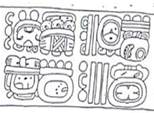![]()
![]()
![]()

![]()
JM.p76.#5 JM.p257.#1 JM.p257.#2 Zürich Panel E6 YAX Lintel 29 H4a
ch’at à
u{h}:ti
u{h}:ti
u{h}:ti
u.<u:ti>
u.u:ti
![]()

![]()


JM.p257.#3 JM.p257.#4 JM.p258.#1 Zender-TRGiCMW.p11.c1.fig9.D3 JM.p258.#2 = TIK Stela 31 F14
u:ti:ji[ya] <u.ti>:ya u:ti:ya <u.ti>.ji[ya] = K7821 <UH.ti>:ya

TIK Stela 31
<UH.ti>:ya
![]()



JM.p258.#3 JM.p259.#1 Stuart-MoTM6.p4 = Stuart-MoTM6.p2
u:to:ma u.<to:ma> u.<to:ma>

Fahsen-RODPD.p15.fig7.r5.A1-B2.HS2.East section
u:to:ma
· Montgomery incorrectly reads JM.p76.#5 as ch’at “dwarf” – Sergei Vepretskii (paraphrased): this cannot be right because the top glyph cannot be ch’a, at the best it could be cha, but cha never has teeth, and if it were, it would spell chat and not ch’at; instead, it’s just a misreading of u{h}:ti uht-i, using the skull variant of u.
· In AT-E1168-lecture20.t0:09:00 Tokovinine explains that in some places there was a regional shift in pronunciation from uht to u’t, resulting in the writing of a double u to indicate the glottalization (see Zürich Panel E6 and YAX Lintel 29 H4a).
· In TIK Stela 31, the UH “necklace” is used as a rebus.
· It has three inflected forms, sometimes called PDI, ADI, and FDI:
o ADI – Anterior Date Indicator: uhtiiy, used for an event which precedes the previously recounted event.
o PDI – Posterior Date Indicator: uhti, used for an event which follows (in time) the previously recounted event.
o FDI – Future Date Indicator: uhtoom, used for an event which follows (in time) the previously recounted event, but in the future:
§ Some epigraphers call the -oom suffix the “definite future” – used when something is known to be going to happen.
§ Some occurrences of uhtoom recount events in the future, and, specifically, events in the distant future which hadn’t happened at the time of the commissioning and erection / dedication of the monument on which the inscription appears. However, there are also occasional instances where the recounted event is after other events on the inscription, and where the event itself has also already taken place. It’s not entirely clear why a PDI is not used in these circumstances.
· There are two related but semantically quite different uses of uht-iiy:
o When followed by a calendar round, then it’s known as an Anterior Date Indicator (ADI), e.g. it (had) happened (on) <CR>.
o When followed by a toponym, then it’s called a “place name formula”, e.g. it happened (at) <toponym>.
· The term place name formula is explained in AT-E1168-lecture17.t0:01:10-01:40: the format is uht-ti-ya <place-name> <landscape-category>, where <landscape-category> = (for example) CHAN-CH’EEN, CHAN-HA’, etc.
· The u- used in uhtoom is the crescent variant rather than boulder (or skull) variant of u (which is used in i-uht-i and uht-iiy) – is this a consistent difference? Dorota Bojkowska: probably not, but no counter examples known.